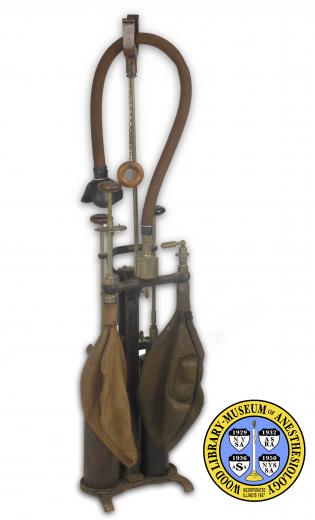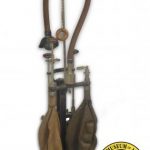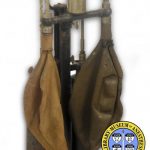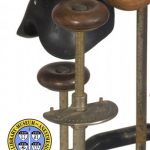S. S. White Two-Cylinder Apparatus
During the late 1800s it was common for dental patients to be administered 100% nitrous oxide (N2O) for anesthesia. This caused the patient to lose consciousness quickly. It could also cause severe hypoxia (lack of oxygen to the body tissues). The S.S. White Two-Cylinder Apparatus, introduced in the late 1890s, was designed in response to calls for the administration of oxygen with N2O. Prominent among the advocates for the addition of oxygen were English physician Sir Frederic W. Hewitt (1857-1916) and American dentist, editor and manufacturer Rev. Samuel J. Hayes (1833-1897).
This was one of the first anesthesia machines to administer both nitrous oxide and oxygen from discrete compressed gas cylinders. The S.S. White Dental Manufacturing Company was a dominant manufacturer and distributor of dental and medical supplies, and a leader in the production of compressed gas cylinders and anesthesia machines. The company was founded in 1844 by dentist Samuel Stockton White (1822-1879). This machine was donated to the Wood Library-Museum by the WLM Honorary Curator, Dr. George S. Bause in honor of Dr. William D. Hammonds, past president of the WLM.
Catalog Record: S. S. White Two-Cylinder Apparatus
Access Key: aiye
Accession No.: 2006-02-18-1
Title: [S.S. White two-cylinder apparatus] / The S.S. White Dental Mfg. Co.
Corporate Author: Samuel S. White Dental Manufacturing Company.
Title variation: Alt Title
Title: S.S. White nitrous oxid and oxygen apparatus.
Title variation: Alt Title
Title: S.S. White’s nitrous oxide and oxygen apparatus.
Title variation: Alt Title
Title: Two-cylinder apparatus for anesthesia by nitrous oxid and oxygen combined.
Title variation: Alt Title
Title: Apparatus for anesthesia by nitrous oxid and oxygen combined.
Title variation: Alt Title
Title: Two cylinder outfit.
Publisher: [Philadelphia] : S.S. White Dental Mfg. Co., [1898-1920].
Physical Description: 1 anesthesia machine : cast iron, brass, other metals, textile (cotton?), rubber, wood, paint ; 118 x 28 x 23 cm
Subject: Anesthesia Machines.
Subject: Anesthesia, Dental.
Subject: Nitrous Oxide.
Subject: Oxygen.
Subject: Cylinders, Gas.
Subject: Anesthesia, Inhalation.
Note Type: General
Notes: Title from an advertisement in a 1901 S.S. White dental instrument catalog;
Alternate titles from advertisements in 1901, 1902 and 1904 publications.
Note Type: Citation
Notes: Thomas KB. The Development of Anaesthetic Apparatus. Oxford: Blackwell
Scientific Pub.; 1975:115, 132-134.
Note Type: Citation
Notes: Bause GS, Conlay LA, Robins J. Treasures of the WLM. ASA Newsl. 2006;70(9):10
Note Type: Physical Description
Notes: Anesthesia apparatus consisting of a cast iron stand for carrying two gas
cylinders (or tanks), and for the delivery of nitrous oxide (N2O) and oxygen
(O2); This description is based on the perspective of a user facing the front
of the device, i.e. “left” is the user’s left, “right” is the user’s right;
Both the stand and gas cylinders are heavily corroded; The front of the
apparatus is the side in which both of the gas bags are visible and each bag
hangs in front of its corresponding gas cylinder; In back on the left is a
gas cylinder approx. 39 cm in height and 9 cm in dia.; In the cylinder’s
valve is a ‘key’ attached to an approx. 29 cm long stem that is topped by a
round, wooden handle that is stained a reddish-brown in color; At the top of
the cylinder a port for tubing extends toward the front of the apparatus; The
tubing that once connected the cylinder to the O2 gas bag is missing from
this apparatus; In back on the right side is a gas cylinder approx. 38 cm in
height and 7 cm in dia. (the N2O cylinder is slightly smaller than the O2
cylinder); In the cylinder’s valve is a ‘key’ attached to an approx. 30 cm
stem that is topped by a round, wooden handle that is stained black; At the
top of the N2O cylinder a port for tubing extends toward the front of the
apparatus; The tubing that once connected the cylinder to the N2O gas bag is
missing from this apparatus; Above and between the two cylinders is handle to
carry the apparatus; Visible on the top of the handle is some of the
ornamentation that was likely once visible on other parts of the apparatus,
but has since warn off; The textile-covered rubber gas bags are of different
colors; Both are stiff and significantly faded; The bag on the left, for O2,
is soiled and rusty-brown in color (and likely was originally red); The bag
on the right, for N2O, is soiled and faded black, or very dark khaki, in
color; Just above where each bag connects to and hangs from the apparatus is
a port that extends toward the back; These ports are where the tubing from
the cylinders would connect; Above each bag is a handle for admitting gas
into the mixing chamber; The handle on the right for the oxygen bag is like
the handle for the oxygen cylinder: round, wooden and stained reddish-brown
in color; It sits atop a stem, 26 cm in height; Between the bag and the
handle, fixed to the tubing for the stem is a metal gauge plate; Along the
front rim on the left side of the gauge plate are depressions marked from 0
to 10; 0 is the depression that is furthest on the left and 10 is the
depression that is located in the front enter of the plate; On the far right
edge of the plate is a depression marked “FULL OPEN”; On the right side of
the plate are the following manufacture markings: “USA [new line] PATENTS
[new line] OCT 13 85 [new line] MAR 22 98 [new lines] GERMANY [new line] D.
R.G.M. 91428”; In the center of the plate is the company logo surrounded by
text following a circular curve: “THE S.S. WHITE DENTAL MFG CO.”; The handle
for the N2O is a simple lever; The mixing chamber located between the two
handles, measures approx. 5 cm dia. and 6 cm in height without its metal
connection tub; The mixing chamber is approx. 13 cm in height with its metal
connection tube; A textile-covered hose would have connected to the mixing
chamber’s connection tube, run through a wood ring hanging from a chain and
ended with a oronasal mask; A stem with a wooden, “U” shaped hook or hanger
extends vertically from between the mixing chamber and carrying handle;
Together the stem and hook measure approx. 62 cm in in height; The face mask
and hose would have been held and hung from the hook.
Note Type: Reproduction
Notes: Photographed by Mr. William Lyle, Sept. 23, 2010; In order to present an
image of the apparatus in the best state possible, it was photographed with
tubing and an oronasal mask from the Parts Collection.
Note Type: Acquisition
Notes: Donated to the Wood Library-Museum by the WLM Honorary Curator, George S.
Bause, MD, in honor of William D. Hammonds, MD.
Note Type: Historical
Notes: A dominant manufacturer and distributor of dental and medical supplies, S.S.
White was an early leader in the production of compressed gas cylinders and
anesthesia machines. The company was founded by dentist Samuel Stockton
White (1822-1879). The design of the SS White Two Cylinder Apparatus,
introduced in 1898 or 1899, was possibly and motivated by Frederick Hewitt’s
‘non-asphyxial’ method of nitrous oxide administration (Thomas, 1975). S.S.
White may also have been motivated by competitors and the work of other
dentists, such as American dentist, editor, and manufacturer Rev. Samuel J.
Hayes (1833-1897).




